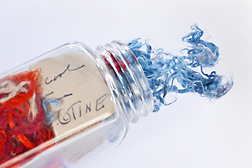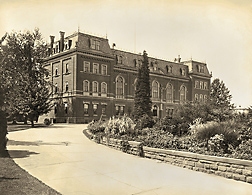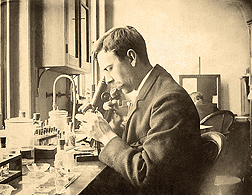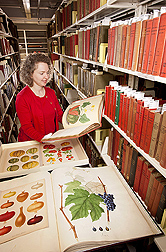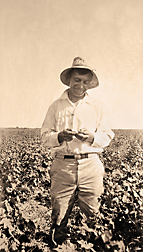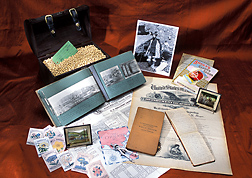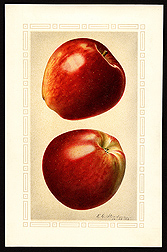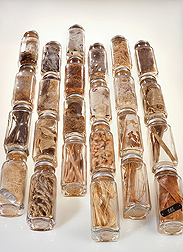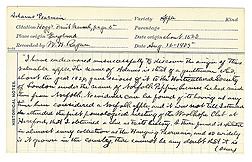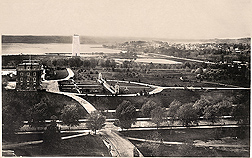USDA’s History Comes Alive
at the National Agricultural Library
More than 100 white boxes fill shelf after shelf of the fifth floor at the National Agricultural Library (NAL), sheltering secrets of U.S. Department of Agriculture parasite investigations from 1886 to 1987. The boxes are filled with line drawings, photographs, lantern slides, research notes, documents, and correspondence that represent the early history of parasitology work, especially in taxonomy and systematics, conducted over the past 100 years and more by USDA scientists.
Such records are not simply the dry dust of USDA history, but rather a continuing resource for researchers today.
“In these records, we’ve discovered extensive but preliminary studies of parasites that had not been named,” says Agricultural Research Service zoologist Eric P. Hoberg, who is with the ARS Animal Parasitic Diseases Laboratory and is chief curator of the U.S. National Parasite Collection.
The extensive collection of documents and images that makes up the U.S. National Animal Parasite Collection Records at NAL complements the U.S. National Parasite Collection, which is among the largest specimen-based collections in the world.
While the records were originally amassed by the antecedents of the parasitic diseases lab, today NAL has USDA’s most effective facilities for preserving such fragile and historically important documents.
These records are important in illuminating the history of parasitology in North America and globally and the history of research conducted on helminth (worms) and arthropod species—mostly ticks—of economic importance in North America, Hoberg explains.
“These records have been central to resolving many issues about the identity and distribution of parasites. For example, the archival material in NAL’s collection provided context for the studies that we completed between 2008 and 2010 exploring the diversity of nematode parasites in African ungulates, which established several new genera and described several new species,” Hoberg says.
|
|
“Particularly important for the scientific papers were the original line drawings that were completed by USDA scientists Willard W. Becklund and M.L. Walker, which were based on collections from Africa that were transferred to Beltsville in the 1960s. We also found detailed line drawings of related specimens that had been borrowed by Becklund from museums in Europe to be very important,” Hoberg says.
As a historical record of the progress of research and the changing focus on different priorities, the archive is simply “irreplaceable,” Hoberg adds.
The NAL parasitology records are just one of more than 200 collections that NAL holds safe and makes accessible that document the history of many of USDA’s programs.
More Than Scientific Literature
When President Abraham Lincoln signed the act that established the U.S. Department of Agriculture in 1862, the legislation included a call for the creation of a library to gather agricultural information. A year later, with a donation of more than 1,000 volumes of agriculture-related materials from the Agricultural Division of the U.S. Patent Office, the Library of the U.S. Department of Agriculture was born. It became the National Agricultural Library in 1962.
Today, NAL also is the repository for more than just scientific literature and agricultural reports. NAL’s special collections encompass correspondence, raw research notes, images, and artifacts, providing a record of how USDA carried out its mission of supporting the nation’s agriculture and the international food and fiber supply.
“With access to original materials from the entire research process, scientists can understand how programs developed and even why certain choices were made,” says Sara B. Lee, NAL Special Collections librarian. “Scientists can consult the historical record and not reinvent the wheel.”
In addition, writers, historians, sociologists, conservationists, and artists regularly turn to the unique records housed in the collections as first-person sources for how USDA events, programs, and policies came about and evolved, Lee adds.
For example, the USDA Pink Bollworm Project Photograph Collection documents USDA work on bollworm detection, prevention, and quarantine measures.
Pink bollworm has been one of the most destructive pests of cotton worldwide and in the United States since it arrived here in the 1920s. USDA control programs began almost immediately and continue today. The Plant Quarantine and Control Administration (later renamed the Bureau of Plant Quarantine), established in 1928, took on responsibility for pink bollworm control. Shifts in the agency in charge of pink bollworm control continued over the years; today the research is with ARS, and the federal regulatory work resides with the Animal and Plant Health Inspection Service.
|
|
“All of the historic records of the pink bollworm program might not have been preserved through those shifts, and scientists might have lost the historic reference base that the material represents,” Lee explains.
Photographs in the collection show subjects such as the researchers’ processes for cleansing the soil of bollworms, the appearance of infested fields, and the effect of bollworms on cotton and other plants.
Plant Hunters
One of the most intriguing historical collections at NAL may be materials from USDA plant explorers. Exploring the world to collect plants that could be beneficial to agriculture was one of USDA’s original charges. The department’s formal program began in 1898 with a corps of USDA plant explorers who brought back unique varieties of crops and their wild relatives from across the globe.
Many of the journals that these explorers kept of what plants they collected, and from where, are now a treasure trove of information about plant germplasm and are often fascinating reading of botanical adventure.
|
|
Among the earliest expedition records are photographs and other materials from USDA plant hunter Frank Meyer, whose trips in the early 1900s yielded an amazing variety of more than 2,500 plant specimens from Asia and Europe: crops from apricots and barleys to the first-ever introduction of zoysia grass into the United States.
“These collections provide detailed information about the characteristics and uses of the plants that the explorers found. They also offer fascinating insights into historical agricultural, social, and environmental conditions in remote parts of the world that were rarely documented elsewhere,” says ARS botanist Karen Williams, who coordinates the modern-day USDA Plant Exploration Program.
Fiber Collection
Some of the NAL collections go far beyond paper and images. The USDA Fiber Collection contains more than 360 bottled samples of noncotton plant fibers along with thousands of pages of information about plants used for paper, cordage, and textiles. The way it came to be preserved in the NAL Special Collections is typical of the way many of the collections ended up there.
In the early 1900s, Lyster H. Dewey, the USDA botanist in charge of fiber plant investigations, first created the collection called the “Dewey Index.” The Dewey Index grew to thousands of index cards and thousands of indexed publications and reprints as USDA fiber specialists researched, traveled, and observed commercial production of fiber and fiber research projects around the world.
|
|
When USDA research work began at Arlington Experimental Farm in 1900—now the south parking lot of the Pentagon in Arlington, Virginia—fiber plants were included, and research on them gradually became a greater part of the activity.
In 1965, research on plant fibers other than cotton was discontinued, and those scientists were transferred to other work. All of the records were being kept by researchers in their various offices. The assembled records were moved to NAL in 1984 to ensure their preservation as a unit.
“This is the most complete file of information in this country, if not the world, on fiber crops of the world. Some of the material and information could never be replaced if this collection were lost,” wrote Allan K. Stoner, while chair of the ARS Plant Genetics and Germplasm Institute.
|
|
Apples, Lots of Apples
The USDA Pomological Watercolor Collection at NAL is not only historically important, it is one of the most attractive. These technically accurate images were their day’s equivalent of photo documentation of fruits and nuts developed by growers or introduced by USDA around the turn of the 20th century. USDA commissioned watercolor artists from 1886 until 1942, and the collection includes 7,584 paintings, lithographs, and line drawings, created by 21 artists.
A companion collection to the pomology watercolors is the USDA Fruit Laboratory Card Catalog Collection [1850s-1940s]. Among the collection’s many documents are the apple history cards, which contain a wide range of information, from locations where different varieties were grown to taste and physical traits.
Some of the apple images and information from the history cards were recently included in an atlas of Old Southern Apples by Lee Calhoun, whose second edition was published in 2010.
In the foreword of his first edition, published in 1995, Calhoun wrote: “These cabinets [at NAL] proved to be an astonishing treasure, containing files compiled by the Division of Pomology of the United States Department of Agriculture (USDA) from 1886 to 1920. Here Edith and I found thousands of handwritten cards chronicling the efforts of the Division of Pomology to trace the origins of old apple varieties. Of greatest interest were excerpts of letters written to the USDA by southerners, giving their recollections.”
|
|
When Calhoun began researching his book in 1988, he expected to find that there had been 300 or 400 different apples grown in the South. Information, much of it from the NAL collections, led Calhoun to eventually document more than 1,800 varieties, many of them no longer being grown today.
Documentation in collections like this, such as where particular varieties were grown and fruit traits and images of varieties that are no longer commonly grown, is an invaluable storehouse of knowledge especially with the growing interest in heirloom varieties, says Susan Fugate, head of NAL Special Collections.
The apple collection has turned out to be very personal for Fugate.
“When Lee Calhoun was here researching for his book, he mentioned references to a Fugate apple variety being grown on the Virginia/Tennessee border,” she explains. “In the 1970s, my dad and I visited the farm of his cousin William Fugate, just on the border in Virginia. It had been in the family a long time, and there was an old apple orchard. I wouldn’t be surprised if those were Fugate apples.”
History Meets the Digital Age
Today, NAL is trying to make its historical collections more accessible and usable. As there are funds and manpower, boxes of records are being more clearly indexed, and documents and images are being scanned. You can find the indexes and scanned materials on the NAL Special Collections webpage (specialcollections.nal.usda.gov) by clicking on “Guide to Collections.”—By J. Kim Kaplan, Agricultural Research Service Information Staff.
To reach people mentioned in this article, contact Kim Kaplan, USDA-ARS Information Staff, 5601 Sunnyside Ave., Beltsville, MD 20705-5128; (301) 504-1637.
What the Mall Once Looked Like
The National Agricultural Library’s Special Collections is home to a unique collection of drawings and photographs that document the evolution of USDA’s buildings on the National Mall from the late 1800s and early 1900s. The images show the lab buildings and greenhouses that used to be there as well the administration buildings that have come and gone.
Below, a photograph (circa 1868) documents the original USDA administration building (left) and the unfinished Washington Monument in the background (center).
|
|
"USDA’s History Comes Alive at the National Agricultural Library" was published in the August 2012 issue of Agricultural Research magazine.







